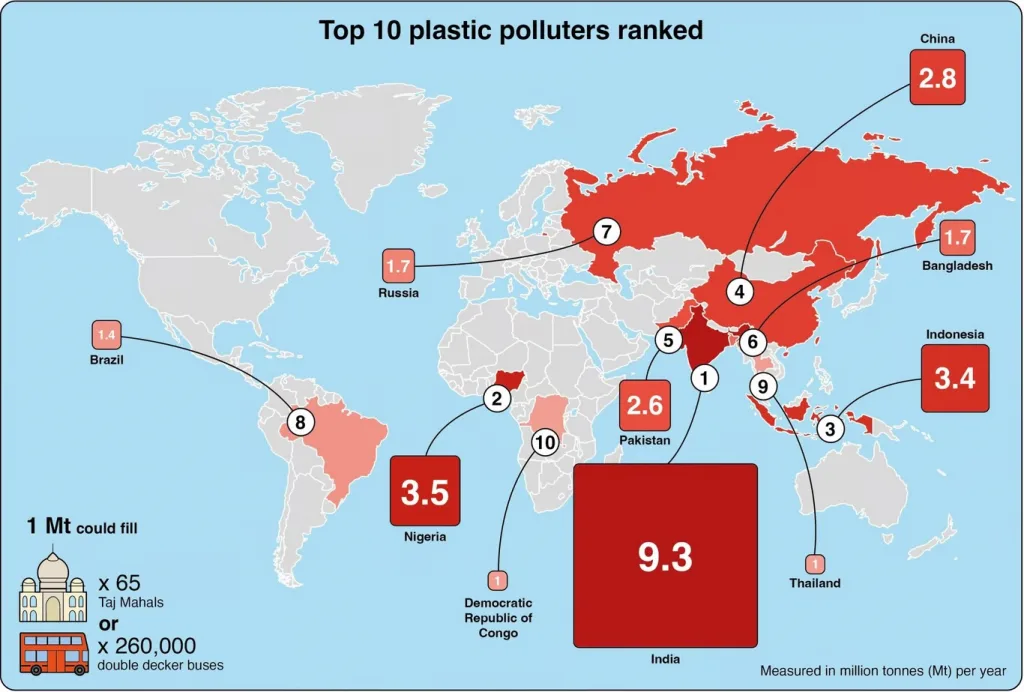Syllabus: GS3/ Environment
Context
- According to a new study published in the journal Nature, India has secured the top spot as biggest plastic polluter in the world, releasing 9.3 million tonnes (Mt) annually.
Key highlights of the study
- The study defines plastic emissions as materials that have moved from the managed or mismanaged system (controlled or contained state) to the unmanaged system (uncontrolled or uncontained state — the environment).
- The plastic pollution from India amounts to roughly one-fifth of global plastic emissions.
- India’s waste generation rate is approximately 0.12 kilograms per capita per day.
- The global plastic waste emissions were at 52.1 Mt per year in 2020.
- While littering was the largest emission source in the Global North, uncollected waste was the dominant source across the Global South.
- The 2nd and 3rd biggest plastic polluters are Nigeria, with 3.5 million tonnes of emissions, and Indonesia, with 3.4 million tonnes.
- Furthermore, high-income countries have higher plastic waste generation rates, but most have 100 per cent collection coverage and controlled disposal, the study highlighted.

Concerns of Plastic Pollution
- Plastics are hard to eradicate due to their slow decomposition rate in natural ecosystems.
- Plastics break down into their smaller units called microplastics, which find their way across the planet, from the depths of the Pacific Ocean to the heights of the Himalayas.
- BPA or Bisphenol A, the chemical which is used to harden the plastic contaminates food and drinks, causing alterations in liver function, fetal development in pregnant women, the reproductive system and brain function.
- Plastic, which is a petroleum product, also contributes to global warming. If plastic waste is incinerated, it releases toxic fumes and carbon dioxide into the atmosphere.
- Plastic waste damages the aesthetic value of tourist destinations, leading to decreased tourism-related incomes and major economic costs related to the cleaning and maintenance of the sites.
Reasons for India’s high plastic pollution
- Inadequate waste management infrastructure: Data from 2019-20 shows that 50% of the total plastic waste in the country (34.7 lakh TPA) remained unutilised, leading it to pollute air, water and soil.
- Data gap: The Public Account Committee observed from CAG’s 2022 audit findings that many state pollution control boards (SPCBs) did not provide data on plastic waste generation for the period 2016-18 and there were inconsistencies in data shared by urban local bodies (ULBs) with SPCBs.
- Recycling inefficiencies: The existing recycling system is largely informal and unregulated, leading to low-quality recycled plastic and limited environmental benefits.
Global Efforts In Tackling Plastic Waste
- London Convention: The 1972 Convention on the Prevention of Marine Pollution by Dumping Wastes and Other Matter.
- Clean Seas Campaign: The United Nations Environment Programme launched the Campaign in 2017. It became the largest global campaign to raise awareness on plastic pollution and marine litter.
- Basel Convention: In 2019, the Basel Convention was amended to include plastic waste as a regulated material.
- The Convention contains three main entries on plastic wastes in Annex II, VIII and IX of the Convention. The Plastic Waste Amendments of the convention are now binding on 186 States.
India’s Efforts In Tackling Plastic Waste
- Extended Producer Responsibility (EPR): The Indian government has implemented EPR, making plastic manufacturers responsible for managing and disposing of the waste generated by their products.
- Plastic Waste Management (Amendment) Rules, 2022: It prohibits manufacture, import, stocking, distribution, sale and use of plastic carry bags having thickness less than 120 microns.
- Swachh Bharat Abhiyan: It is a national cleanliness campaign, which includes the collection and disposal of plastic waste.
- Plastic Parks: India has set up Plastic Parks, which are specialized industrial zones for recycling and processing plastic waste.
- Beach clean-up drives: The Indian government and various non-governmental organizations have organized beach clean-up drives to collect and dispose of plastic waste from beaches.
Way Ahead
- To tackle the challenge of plastic pollution there is a need for behavioral change and strengthening of the institutional system for the collection, segregation and recycling of plastic waste.
- Under the UN Environment Assembly Resolution 5/14, the Intergovernmental Negotiating Committee (INC) is responsible for delivering a legally binding global plastics treaty by the end of 2024.
Source: DTE
Previous article
Technical Textiles Will Cross $10 Billion by 2030
Next article
Jal Sanchay Jan Bhagidari Initiative